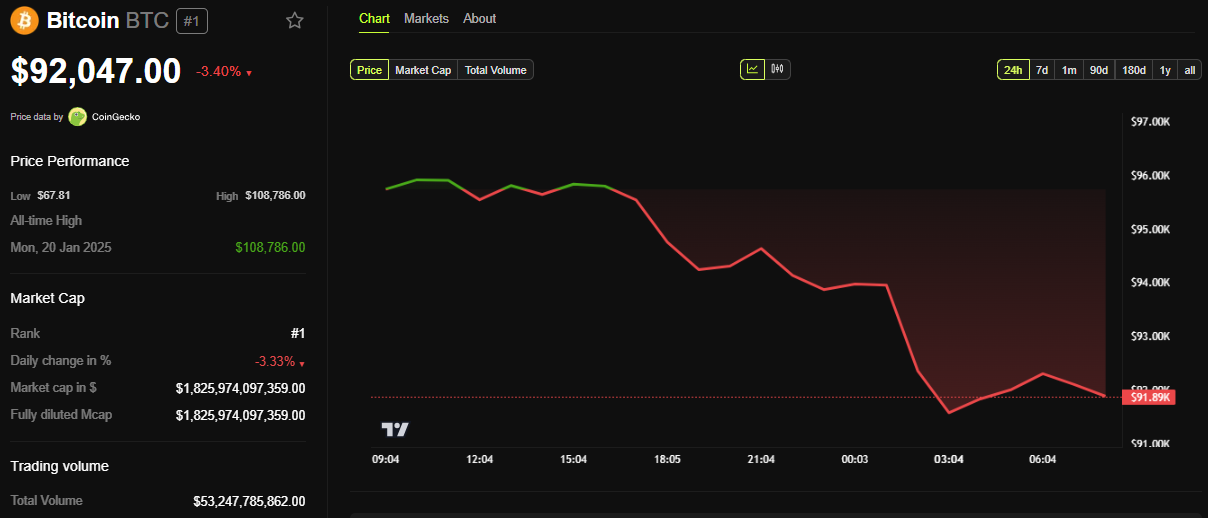-
Bitcoin experienced a significant downturn, dropping below $92,000, spurred by President Trump’s announcement of tariffs on Canada and Mexico.
-
This drastic shift in the crypto market underscores Bitcoin’s escalating sensitivity to macroeconomic events, with Coinglass reporting $918 million in liquidations.
-
Historical data reveals that Trump’s tariff policies have previously resulted in substantial market sell-offs, having triggered a $2 billion loss in February 2025.
This article explores the crypto markets’ reaction to recent tariff announcements, highlighting Bitcoin’s volatility and market liquidations amidst macroeconomic tensions.
The Impact of Trump’s Tariffs on Cryptocurrency
The recent announcement by President Trump concerning the imposition of tariffs on Canadian and Mexican goods sent shockwaves across the cryptocurrency market. Bitcoin, the leading digital currency, promptly fell below the crucial support level of $92,000 as the market reacted to macroeconomic uncertainties. Analysts have noted that these tariff hikes are indicative of broader geopolitical tensions, which tend to destabilize market confidence.
A Closer Look at Market Reactions
With Trump’s statements indicating that the US is on “time with the tariffs,” the crypto market faced immediate pressure. According to a Coinglass report, the latest price drop resulted in almost $918 million in liquidations across the industry, reflecting a high level of market responsiveness to public policy changes. Investors’ anxiety over the possibility of rising costs on goods could herald inflation, leading to further sell-offs. The total liquidation figure reveals that nearly 299,006 traders were affected during this volatile trading period.

The significant number of liquidations, particularly on long positions, suggests that investors may have underestimated the potential impact of Trump’s tariff announcements—a costly oversight that has historically led to considerable losses. In earlier instances, similar tariff actions have seen the cryptocurrency market suffer major setbacks, including a $2 billion valuation decline earlier this year.
Patterns of Market Volatility and Recovery
While the immediate effects of Trump’s tariffs are disconcerting, patterns in market behavior reveal potential opportunities for astute investors. After the February tariff announcements led to widespread liquidations, the market eventually rebounded when reprieve news circulated. JPMorgan‘s recent findings bolster this view, suggesting that tariffs and inflation are primary influences shaping market dynamics in 2025.

Eddie Wen, from JPMorgan Chase, emphasized the tendency for markets to exhibit “knee-jerk reactions” in response to sensational headlines in the political arena. As the market adjusts to new information, investors like Michael Saylor of MicroStrategy view these downturns as market corrections, yielding potential buying opportunities. Saylor’s commentary, aligning with financial experts such as Robert Kiyosaki, endorses the notion that strategic buying during perceived dips could enhance long-term portfolio value.
Long-term Strategies Amidst Political Uncertainty
Amid these fluctuations, notable analysts have quantifiably assessed the impacts of political maneuvers on the cryptocurrency market. One such analyst pointed out on social media that Trump’s administration has allegedly led to over $734 billion in losses for the cryptocurrency sector since he assumed office. This highlights the fragile connection between political policy and market health.

As of the current trading session, Bitcoin rebounded slightly, trading at approximately $92,047, demonstrating a decline of 3.4% since the opening. As investors tread carefully, the future trajectory of Bitcoin and the broader crypto market will likely hinge on geopolitical developments and economic policies.
Conclusion
In summary, Bitcoin’s recent price movements reflect a broader sensitivity to geopolitical events like the Trump tariffs on Canada and Mexico. The substantial liquidations cements the reality that cryptocurrencies are now more tethered to macroeconomic narratives than ever before. Investors will need to remain vigilant and prepared to adapt their strategies in the face of ongoing political uncertainties, ensuring they capitalize on potential recovery trends following market corrections.







